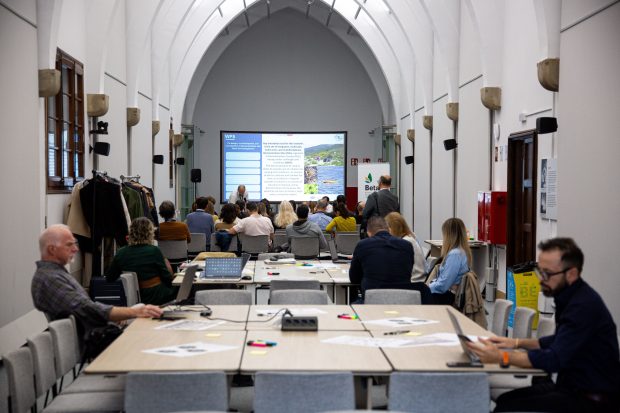The BETA TC starts the SEACURE project to tackle nutrient pollution in the Mediterranean Sea
Through prevention, reduction and remediation solutions, the aim is to mitigate excess nutrients (nitrogen and phosphorus), which are transported by terrestrial systems through rivers to the sea, and can lead to eutrophication of the ecosystem.

Many of the nutrients, such as nitrogen and phosphorus, which are found in fertiliser products for agricultural growth, travel through rainfall to rivers, which then flow into the sea. Alternatively, these nutrients are also found in the water that comes out of sewage treatment plants and then goes into rivers. This can lead to an imbalance in the aquatic ecosystem that can result in eutrophication.
What is eutrophication and how can it be mitigated?
Excess and imbalance of nutrients induces algal blooms in aquatic ecosystems. This causes a series of chain reactions with serious consequences such as oxygen starvation that leads to the further death of life forms, such as fish.
To address this problem, the BETA Technological Centre of the UVic-UCC has launched the SEACURE. This project, coordinated by the BETA TC itself with funding from the Horizon Europe Programme, has 25 partners from all over Europe. In Catalonia, the Department of Agriculture, Fisheries, Livestock and Food of the Generalitat de Catalunya, CREAF, the Catalan Water Cluster, the Asociació l’Era and MedWaves (a centre integrated in the Catalan Waste Agency) are part of the project.
SEACURE aims to tackle nutrient pollution in the soil-river-sea system in the Mediterranean. The innovative solutions to be demonstrated are divided into three categories focusing on prevention, reduction and remediation. They will be tested in 6 pilot areas in 3 Mediterranean countries; Spain, Italy and Greece. These are areas where excess nutrient problems are most prevalent. In Spain in the areas of the Mar Menor (Murcia) and Central Catalonia, in Italy in the Po Delta and the river Esino, and in Greece in the Axios Delta.
Preventing nutrient loss from the start
The project aims to implement strategies to prevent excess nutrient inputs into agricultural systems. This requires finding solutions to reduce the use of mineral fertilisers, such as promoting precision farming practices, where nutrients are used only in areas where they are needed. Or encouraging perennial crops, which are crops that can help prevent nutrient loss and improve soil health. The implementation of tailor-made fertilisers (TMF) from organic livestock waste. Or fertigation, which involves using nutrient-enriched water from human or livestock sources to irrigate and fertilise fields at the same time. This system limits the application of mineral fertilisers and favours the circularity of nutrients.
Reducing the loss of nutrients into rivers
The project aims to implement strategies to reduce the input of nutrients from wastewater treatment plant effluents into aquatic systems such as rivers. Among the solutions proposed are nature-based solutions (known as NBS) such as phytoremediation, which involves using natural organisms like microalgae in wastewater treatment systems. These reduce the nutrient load at the outlet of wastewater treatment plants. Another strategy to be tested is the creation of artificial wetlands, where water from wastewater treatment plants will be diverted to plants and bacteria to perform a purification function. Technological solutions such as biological denitrification will also be included. This technology uses bacteria that remove nitrates from the water in a controlled manner. This methodology will be used to treat run-off water from agricultural fields around the Mar Menor basin in Murcia.
Remedying nutrient loss before it reaches the sea
Solutions are to be implemented in the end zones of rivers to prevent nutrients from reaching the sea. In Greece, for example, the construction of floating islets with long-rooted plants capable of capturing nutrients from the water is being considered. In Italy, in the Po Delta, a network of irrigation canals was created years ago for agricultural use, and when full, these canals contribute large quantities of nutrients to the Adriatic Sea. To mitigate this impact, a vegetation strip will be installed and managed around the canals, whose roots harbour denitrifying bacteria that have a high capacity to reduce the levels of nutrients transported downstream.
The aim is to see if the solutions and results obtained in Mediterranean regions are scalable to other areas and countries. In this way, evidence can be provided that can facilitate decision making on holistic nutrient management policies at regional scales. For example, in seas such as the Baltic, which also have high levels of eutrophication. The idea is that affected countries not participating in the consortium can replicate some of these strategies in the second phase of project implementation.
